The reproduction process is diverse among species, from bacteria to plants, insects, amphibians, fish, reptiles, birds, and mammals. But it is not just the process of reproduction alone that is so diverse. The varying gestation lengths of species are equally fascinating! Placental mammals, including humans, horses, elephants, and domestic cats, typically have long gestation periods, ranging from 2 months to almost two years. On the other hand, some other species of the animal kingdom give birth to their offspring within just a matter of weeks.
This article will discover some animals with the shortest gestation periods.
But Why Do Some Animals Have Short Gestation Periods?
Two main factors contribute to shorter pregnancies in some animal species- animal size and the level of development at birth. Smaller species typically have short gestation periods as they grow more quickly, age more rapidly, and have shorter lifespans than larger species. On the other hand, larger animal species like the elephant, for example, can have a ‘bun in the oven’ for almost two years- the longest gestation period among mammals!
But then again, you must remember that nothing about these creatures is small, especially their babies. A baby elephant or calf weighs approximately 200 pounds at birth, and elephants have to endure longer pregnancies to develop a baby of that size. The long gestation period of an elephant also ensures that its calves arrive with a brain that is already pretty well-developed when they are born.
In contrast to these painfully long pregnancies, you will be amused to learn how quickly some other animal babies are formed and birthed. Most of these baby mammals born through short gestation periods are incredibly small and immature; most of their development occurs outside the mother’s womb. Here’s a look at ten animals (mammals) with the shortest gestation periods.
10 Mammals With The Shortest Gestation Periods
1. The Virginia Opossum (Didelphis virginiana)

The Virginia (or common) opossum is a marsupial. Marsupials are the only mammals that incubate and carry their young in a pouch.
©iStock.com/randimal
The Virginia opossum, identified as North America’s only marsupial, has a very short gestation period, lasting for only about 12 to 13 days.
The young joeys are only the size of a small jellybean, about 0.5 inches (14 millimeters) long when born. The opossum babies are born blind and furless and look nothing like adult opossums. Right after birth, they crawl back into their mother’s pouch and remain there for about two weeks until they fully develop. The litter sizes of the Virginia opossum may vary from 4 to 25, and female opossums breed twice per year on average. The young joeys are weaned off their mother’s milk after about 70 to 105 days.
2. Water Opossum (Chironectes minimus)

The water opossum or yapok is the only aquatic marsupial. They usually breed in December.
©Leonardo Mercon/Shutterstock.com
The water opossum, locally called yapok or yapock, is a species native to the Neotropics. Like the Virginia opossum, they have very short gestation periods of about 12 to 14 days.
An average litter of water opossums consists of around 3 to 4 offspring. Immediately after birth, the opossum babies climb into their mother’s pouch and start suckling. They develop fur and open their eyes when they are about 38 days old. When they open their eyes, the young opossums are often too large to remain in their mother’s pouch. The young opossums wean off after 45 to 60 days and become capable of surviving on their own.
3. Hamsters (Cricetinae)
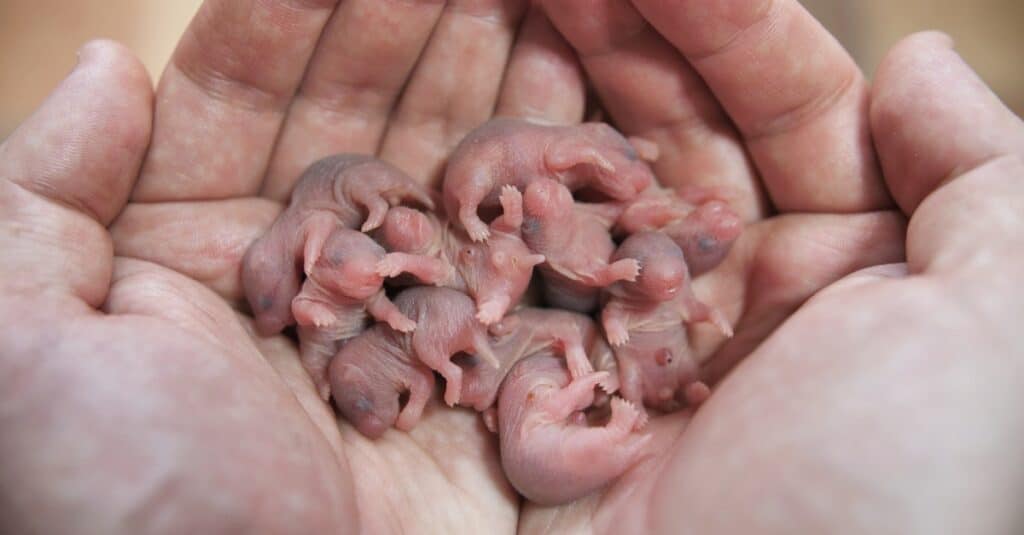
The picture shows newborn bald hamsters.
©iStock.com/Mikhail Davidovich
Hamsters are another animal species fortunate to have shorter pregnancies. The average length of a pregnancy for a hamster is usually around 16 to 21 days, depending on the species. Syrian hamsters typically have the shortest gestation period of just 16 days. For Chinese and Russian Dwarf hamsters, on the other hand, pregnancy could last for about 18 to 21 days. In Roborovski hamsters, pregnancies may be a little longer, lasting about 30 days.
Like several other animal species, hamster babies called ‘pups’ are born naked and blind. However, they grow rapidly; by 3 to 4 weeks, they resemble miniature adults.
4. The Eastern Quoll (Dasyurus viverrinus)
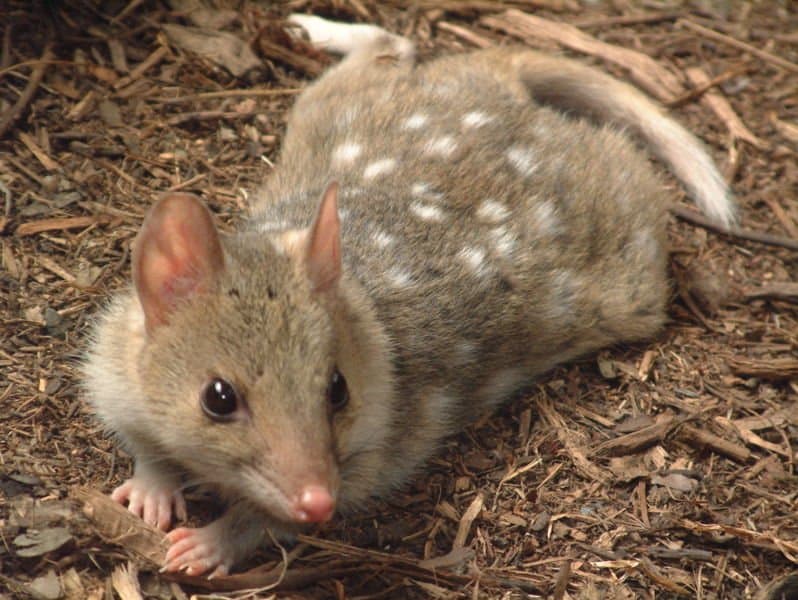
The Eastern Quoll (
Dasyurus viverrinus) has a single breeding season between late fall and early winter.
The eastern quoll, formerly known as the eastern native cat, is a marsupial cat found only in Australia. They have a gestation period of 20 to 24 days.
The litter size of the eastern quoll is fairly large, and they can give birth to up to 30 young at a time. However, they only have 6 to 8 mammae in their pouch, and the first joeys that attach themselves to the mother are the only ones who survive. Eastern quoll joeys remain in their mother’s pouch for their first ten weeks. They wean off and become independent when they are about 18 to 20 weeks of age.
5. Mice (Mus musculus)

Mice and rats are capable of giving birth at a very young age.
©Jennifer Thornhill/Shutterstock.com
The average gestation period for mice is 19-21 days, depending on the species. Apart from having short gestation periods, these species also have incredible breeding capabilities. A single female mouse can have up to 5-10 litters yearly. These litters may typically consist of 6 to 8 babies at a time.
Mice babies or pups are born hairless and blind and cannot hear until they are about three weeks of age. Because of how helpless they are when they are born, mothers nurse their babies for 21-28 days. But it is also not unusual to see first-time mothers cannibalize their litters.
6. Rats (Rattus)
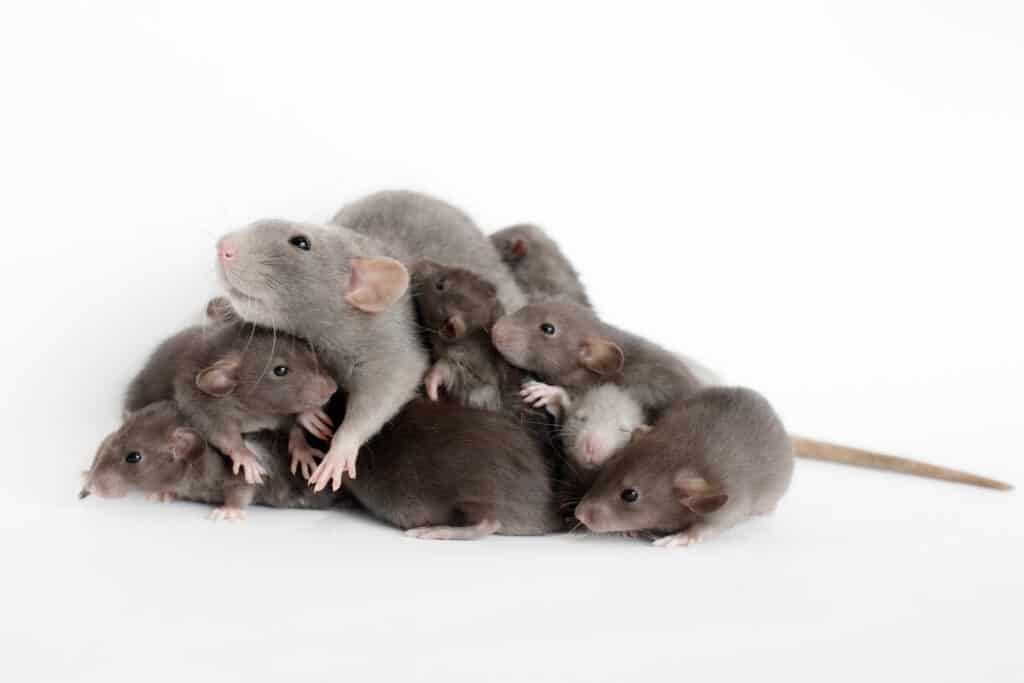
Mother rats spend a lot of time nursing, licking, and grooming their pups.
©Maryia Karneyenka/Shutterstock.com
Gestation in rats typically lasts about 21 to 23 days. Like mice, rats are also prolific breeders. A single female rat can produce up to 12 litters of 2 to 22 young per year.
Once the pups are born, the mother will usually retrieve the babies and keep them in the nest. The pups remain with their mothers until they reach 14-15 days old and can open their eyes.
7. Gerbil (Meriones unguiculatus)
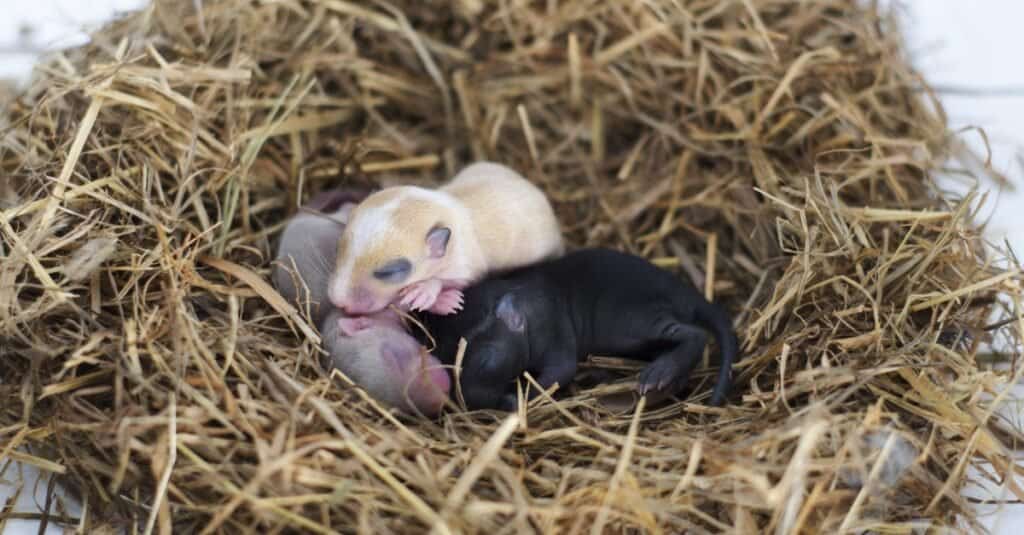
The picture shows young Mongolian gerbils. These young are blind and will only open their eyes at 14 to 20 days.
©February Sweet/Shutterstock.com
The gerbil is a desert-dwelling rodent with a gestation period of 21 to 25 days. These creatures breed year-round and are known for their ability to conceal their pregnancies. They do not show any visible signs of pregnancy until just before they give birth!
The average litter size of the gerbil is 4-6, and the young weigh approximately 3 grams at birth. Gerbils are born with closed eyelids and ears and fully depend on their mothers for the first six weeks of their life.
8. Wombat (Vombatus ursinus)
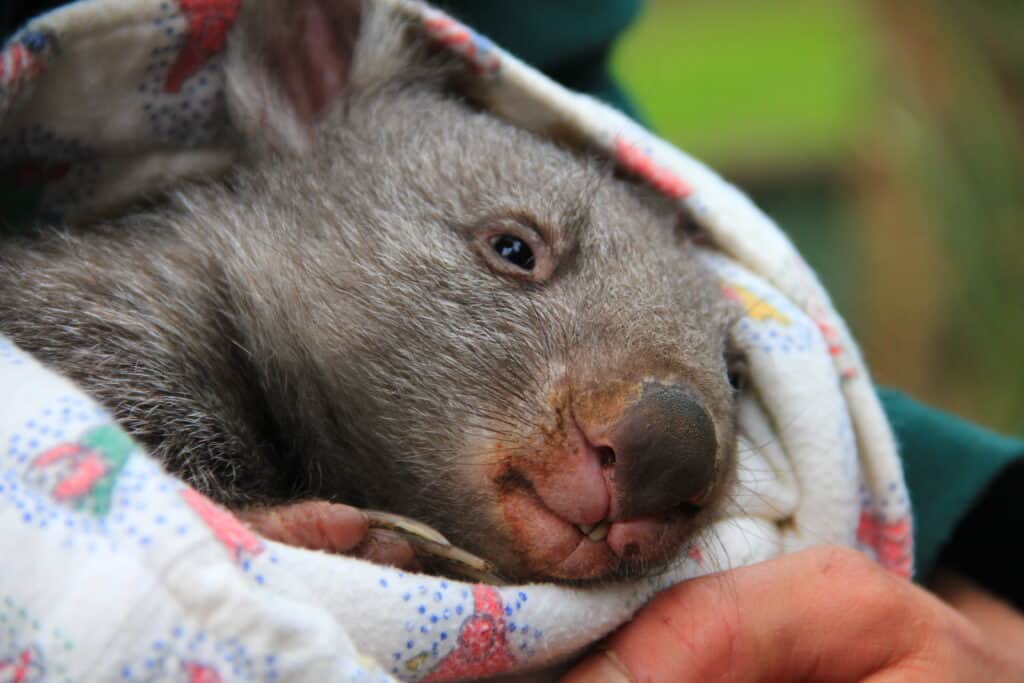
Newborn wombats are about 3cms long when born and weigh around 1 gram.
©Flash-ka/Shutterstock.com
Wombats are short-legged marsupials native to Australia. They have a gestation period of roughly 20 to 30 days.
A female wombat gives birth to a single offspring. Like all female marsupials, the newborn joey is carried in its mother’s pouch until it turns 9 to 10 months old. The young joey is weaned from its mother’s milk after 12 to 15 months.
9. Muskrat (Ondatra zibethicus)

Baby Muskrats or kits grow rapidly and can swim, dive, and feed themselves when just 30 days old!
©Tony Campbell/Shutterstock.com
Muskrats are semiaquatic rodents native to North America. The gestation period for Muskrats is 25 to 30 days. These organisms are blind for the first two weeks of their lives. Muskrats venture out of their den for their first swim when their vision develops.
On average, Muskrats can have up to 3 litters a year, giving birth to 4-8 kits at a time.
10. Domestic Rabbits (Oryctolagus cuniculus domesticus)
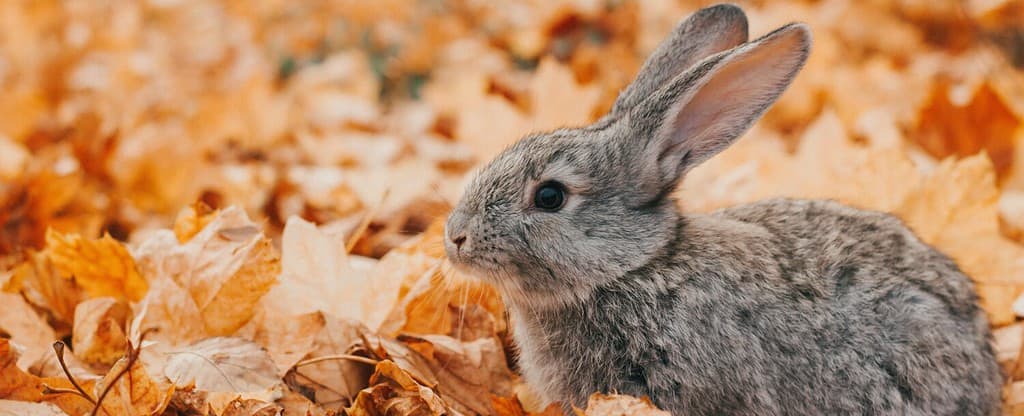
Rabbit mammas usually stay away from their offspring after they are born. They do this to avoid attracting predators to their babies.
©Evgeniy Goncharov photo/Shutterstock.com
Domestic rabbits, commonly referred to as pet rabbits or bunny rabbits, are known to be endearing pets. Gestation in rabbits typically lasts 28-31 days.
These creatures are also notorious for their quick reproductive abilities. If you don’t spay or neuter a female rabbit, it could have one litter per month. But that’s not all; mother rabbits can also be impregnated again just minutes after giving birth.
Like the Gerbil, pregnancy in rabbits is not always obvious until a few days before birth. Once the kits are born, it is normal for rabbit mothers to show little maternal care. They may leave the nest and return only for a few minutes daily to feed their litter.
Summary of The Top Ten Animals With the Shortest Gestation Period
| Mammal | Scientific Name | Length of Gestation |
|---|---|---|
| Virginia Opossum | Didelphis virginiana | 12-13 days |
| Water Opossum | Chironectes minimus | 12-14 days |
| Hamsters | Cricetinae | 16-21 days |
| Eastern Quoll | Dasyurus viverrinus | 20-24 days |
| Mice | Mus musculus | 19-21 days |
| Rats | Rattus | 21-23 days |
| Gerbil | Meriones unguiculatus | 21-25 days |
| Wombat | Vombatus ursinus | 20-30 days |
| Muskrat | Ondatra zibethicus | 25-30 days |
| Domestic Rabbits | Oryctolagus cuniculus domesticus | 28-31 days |
The photo featured at the top of this post is © Nilanka Sampath/Shutterstock.com
Thank you for reading! Have some feedback for us? Contact the AZ Animals editorial team.






